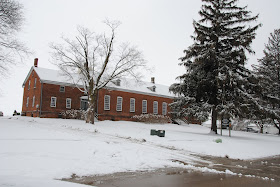Often when driving on Interstate 80, we drive by a sign advertising the Amana Colonies. My parents visited once and Mom told me we should do so sometime.
As we had the time, we made arrangements to stay at Die Heimat B&B in Homestead, Iowa. It was an original 1850's inn for the stagecoach and train stop, and also a communal kitchen.
 Marc and June Hershberger run this bread and breakfast. They used to work with MCC in Tanzania. When we made reservations, we had to visit on the phone and try to make connections, since we are both Mennonite background. (This is called the Mennonite Game.) We have Hershberger friends, but they are not related, although probably distantly.
Marc and June Hershberger run this bread and breakfast. They used to work with MCC in Tanzania. When we made reservations, we had to visit on the phone and try to make connections, since we are both Mennonite background. (This is called the Mennonite Game.) We have Hershberger friends, but they are not related, although probably distantly.We found out that they had been in our city in Kansas visiting friends and had traveled back to Amana the same day we were on the road.
We were served blueberry oatmeal pancakes,
sausage and an egg cup for breakfast.
Delicious!
Our church library had the fiction work "Daughters of Amana" that I had read. It was quite interesting about this group of people who came to America from Germany seeking religious freedom.
They are a communal group, with 7 villages, a mile or two apart. The villages were built an hour apart when traveling by ox cart.
In these 7 villages, residents received housing, medical care, meals, all household necessities and schooling. Property and resources were shared. Every man and woman was assigned a job by the village council of brethern. No one received a wage.
Each village has their own church. Although the people live in individual homes, having given up the communal way of living in 1932, they still have church together. Men and women sit on opposite sides of the church. Hymns are sung a Capella with the aid of song leaders. They welcome visitors to worship with them.
We learned that each village had their own still that was kept in the basement of the churches. Each man was allotted 1 gallon of wine per month. Each woman given 1/2 gallon. The luckiest men were those whose wives did not like the taste of wine. Ha!
They lived in multi-family residences with communal kitchens. Several women worked in these kitchens and fed up to 10 families. There were over 50 communal kitchens that provided 3 daily meals as well as mid-morning and afternoon snacks. They were supplied by the village smokehouse, bakery, ice house and dairy as well as the gardens. While many women worked in the kitchens, other women worked in the gardens or kept care of children.
Each village had their own shops, doctors, dentists and pharmacists, woolen mills, lumber yards and such. Farming was the principal means of support. No one had a salary. They shared what they had with each other.
Their day to day life revolved around worship (attended 11 times a week), home, work and school. Schools were attended 6 days a week, year-round by the children.
We had planned to have a private tour with an elderly gentleman, but he was cautious about the snow we had received the night before. So June gave us a little bit of information we needed to know and which places we should stop for a self tour.
My friends who love quilting would love this shop, Fern Hill, in South Amana. It has quilting materials, antiques and many beautiful things for the home! You can order on-line!
Driving between villages, toward West Amana
Have you heard of Amana appliances?
Whirlpool now owns and manufactures them.
Whirlpool Corp. is located in Amana and employs over 20,000 people,
many from the Amana villages, but also from surrounding cities.
We stopped at the Museum of Amana Histories where we watched a 20 minute film about the colonies.
A meteorite
On the evening of 12 February 1875 above Iowa a brilliant fireball was observed. About 100 meteorite fragments fell over a 18-square-mile snowy countryside area from Amana to Boltonville in Iowa County. The first found fragment, a stone weighing about 7.7 lb, was discovered by Sarah Sherlock 1.9 mi south of Homestead. The area was wooded and covered by snow, impeding recovery efforts. On February 10 a 16 in snowfall blanketed the ground, preventing the great majority of the fragments from being discovered until Spring. The 74 pounds main mass was found along with a 48 pounds fragment buried 2 feet in the soil. As of December 2011, approximately 510 lb has been found.
Time for lunch!
Good German food! Since we are Swiss-German, it is comfort food for us! We ordered the oven baked steak which had been on the menu of the communal kitchens. We almost always only order 1 meal and split it.
We also split the apple pie ala mode!
We needed gas before leaving the colonies.
This gas station had to meet the requirements for building codes to make it look like the historical buildings of the area. I'm guessing it is the only Casey's that looks like this!




















































